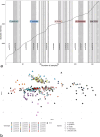High diversity of crustose coralline algae microbiomes across species and islands, and implications for coral recruits
- PMID: 39710769
- PMCID: PMC11663328
- DOI: 10.1186/s40793-024-00640-y
High diversity of crustose coralline algae microbiomes across species and islands, and implications for coral recruits
Abstract
Background: Crustose Coralline Algae (CCA) play a crucial role in coral reef ecosystems, contributing significantly to reef formation and serving as substrates for coral recruitment. The microbiome associated with CCAs may promote coral recruitment, yet these microbial communities remain largely understudied. This study investigates the microbial communities associated with a large number of different CCA species across six different islands of French Polynesia, and assess their potential influence on the microbiome of coral recruits.
Results: Our findings reveal that CCA harbor a large diversity of bacteria that had not been reported until now. The composition of these microbial communities was influenced by geographic location, and was also closely linked to the host species, identified at a fine taxonomic unit using the 16S rRNA gene of the CCA chloroplast. We demonstrate the usefulness of these ecologically meaningful units that we call CCA chlorotypes. Additionally, we observed a correlation between host phylogeny and microbiome composition (phylosymbiosis) in two CCA species. Contrary to expectations, the CCA microbiome did not act as a microbial reservoir for coral recruits. However, the microbial community of coral recruits varied according to the substrate on which they grew.
Conclusions: The study significantly expands the number of characterized CCA microbiomes, and provides new insight into the extensive diversity of these microbial communities. We show distinct microbiomes between and within CCA species, characterized by specific chloroplast 16S rRNA gene sequences. We term these distinct groups "chlorotypes", and demonstrate their utility to differentiate CCA. We also show that only few bacterial taxa were shared between CCA and coral recruits growing in contact with them. Nevertheless, we observed that the microbial community of coral recruits varied depending on the substrate they grew on. We conclude that CCA and their associated bacteria influence the microbiome composition of the coral recruits.
Keywords: Bacteria; Coral; Coral recruitment; Crustose coralline algae; Interaction; Microbiome.
© 2024. The Author(s).
Conflict of interest statement
Declarations. Ethics approval and consent to participate: Not applicable. Consent for publication: Not applicable. Competing interests: The authors declare no competing interests.
Figures







Similar articles
-
Species-Specific Differences in the Microbiomes and Organic Exudates of Crustose Coralline Algae Influence Bacterioplankton Communities.Front Microbiol. 2019 Nov 8;10:2397. doi: 10.3389/fmicb.2019.02397. eCollection 2019. Front Microbiol. 2019. PMID: 31781048 Free PMC article.
-
Crustose coralline algae increased framework and diversity on ancient coral reefs.PLoS One. 2017 Aug 4;12(8):e0181637. doi: 10.1371/journal.pone.0181637. eCollection 2017. PLoS One. 2017. PMID: 28783733 Free PMC article.
-
Elevated seawater temperature causes a microbial shift on crustose coralline algae with implications for the recruitment of coral larvae.ISME J. 2011 Apr;5(4):759-70. doi: 10.1038/ismej.2010.152. Epub 2010 Oct 14. ISME J. 2011. PMID: 20944682 Free PMC article.
-
Coral larval settlement preferences linked to crustose coralline algae with distinct chemical and microbial signatures.Sci Rep. 2021 Jul 16;11(1):14610. doi: 10.1038/s41598-021-94096-6. Sci Rep. 2021. PMID: 34272460 Free PMC article.
-
Ocean acidification reduces induction of coral settlement by crustose coralline algae.Glob Chang Biol. 2013 Jan;19(1):303-15. doi: 10.1111/gcb.12008. Epub 2012 Sep 25. Glob Chang Biol. 2013. PMID: 23504741 Free PMC article.
Cited by
-
Microbiome Dynamics in Early Life Stages of the Precious Mediterranean Red Coral Corallium rubrum.Environ Microbiol Rep. 2025 Jun;17(3):e70127. doi: 10.1111/1758-2229.70127. Environ Microbiol Rep. 2025. PMID: 40526476 Free PMC article.
References
-
- Abrego D, Van Oppen MJH, Willis BL. Onset of algal endosymbiont specificity varies among closely related species of Acropora corals during early ontogeny. Mol Ecol. 2009;18:3532–43. 10.1111/j.1365-294X.2009.04276.x. - PubMed
-
- Apprill A, Hughen K, Mincer T. Major similarities in the bacterial communities associated with lesioned and healthy Fungiidae corals. Environ Microbiol. 2013;15:2063–72. 10.1111/1462-2920.12107. - PubMed
-
- Apprill A, Marlow HQ, Martindale MQ, Rappé MS. The onset of microbial associations in the coral Pocillopora meandrina. ISME J. 2009;3:685–99. 10.1038/ismej.2009.3. - PubMed
-
- Bailey JC. Phylogenetic positions of Lithophyllum incrustans and Titanoderma pustulatum (Corallinaceae, Rhodophyta) based on 18S rRNA gene sequence analyses, with a revised classification of the Lithophylloideae. Phycologia. 1999;38:208–16. 10.2216/i0031-8884-38-3-208.1.
Grants and funding
LinkOut - more resources
Full Text Sources
Miscellaneous
